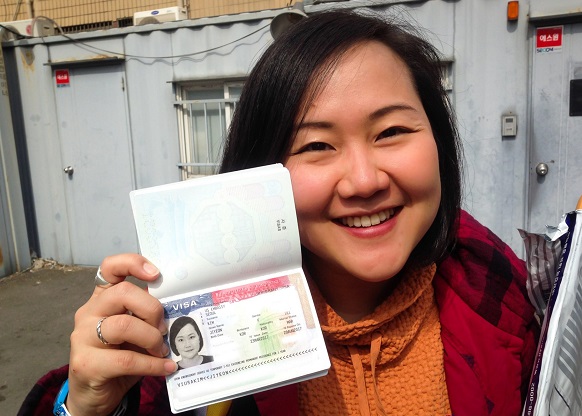Apply for Spouse Visa in USA – Bringing your spouse to the United States to live with you can be an exciting but complex process. If you are a U.S. citizen or a lawful permanent resident (green card holder), you have the opportunity to sponsor your foreign-born spouse for a spouse visa, also known as the Marriage-based Visa or CR-1/IR-1 visa. This visa enables your spouse to legally reside and work in the United States, ultimately paving the way for permanent residency and, eventually, U.S. citizenship.
Navigating the spouse visa application process successfully is crucial to reuniting with your loved one.
In this comprehensive guide, we will break down the steps involved in applying for a spouse visa in the United States, helping you understand the requirements, procedures, and documents necessary for a smooth and successful application.
From establishing your eligibility and filing the necessary forms to completing the interview process and adjusting status, we will walk you through the essential steps, making the process as straightforward as possible. Whether you are a U.S. citizen or a green card holder seeking to bring your spouse to the U.S., this guide will serve as your roadmap to reunification.
Let’s embark on this journey together and ensure that your spouse can join you in the land of opportunity.
Types of Spouse Visa in USA
The United States offers several types of spouse visas for foreign nationals who wish to join their U.S. citizen or permanent resident spouse. It’s important to note that immigration policies can change over time, so it’s crucial to consult the official U.S. Citizenship and Immigration Services (USCIS) website or seek legal advice for the most up-to-date and accurate information.
Below, we’ll provide an extensive explanation of some common types of spouse visas in USA:
1. K-1 Fiancé(e) Visa:
- The K-1 visa is for foreign nationals engaged to a U.S. citizen who plan to marry and reside in the United States.
- It allows the foreign fiancé(e) to enter the U.S. for a 90-day period to get married.
- After marriage, the foreign spouse can apply for Adjustment of Status to become a permanent resident.
2. CR-1 and IR-1 Visa (Spouse of a U.S. Citizen):
- The CR-1 (Conditional Resident) and IR-1 (Immediate Relative) visas are for foreign spouses of U.S. citizens.
- The CR-1 visa grants conditional permanent residence if the marriage is less than two years old.
- The IR-1 visa grants immediate permanent residence if the marriage is over two years old.
- These visas are issued abroad and, upon entry, the spouse becomes a conditional or permanent resident, respectively.
3. K-3 Visa (Spouse of a U.S. Citizen):
- The K-3 visa is for foreign spouses of U.S. citizens when the U.S. citizen spouse has filed an immigrant petition on their behalf.
- It allows the foreign spouse to enter the U.S. while waiting for the I-130 petition (Form for Alien Relative) to be processed.
- Once in the U.S., the K-3 spouse can apply for Adjustment of Status to become a permanent resident.
4. F2A Visa (Spouse of a U.S. Permanent Resident):
- The F2A visa category is for spouses and unmarried children (under 21) of U.S. permanent residents.
- There is a waiting period for visa availability based on the preference category, as the number of visas issued in this category is limited.
5. VAWA (Violence Against Women Act) Self-Petition:
- This visa option is for abused spouses (and their children) of U.S. citizens or permanent residents.
- It allows victims of domestic violence to self-petition for a green card without the abuser’s involvement.
6. Same-Sex Marriage Visas:
Following the Supreme Court’s decision in 2015 legalizing same-sex marriage across the United States, same-sex couples are eligible for the same spousal visas as opposite-sex couples.
Requirements To Apply For The Spouse Visa In USA
To apply for a spouse visa in the United States, you’ll typically be applying for a family-based immigrant visa, which allows the foreign national spouse of a U.S. citizen or permanent resident to live and work in the United States.
The process can be quite complex, and requirements may vary depending on the specific circumstances, so it’s important to consult the official website of the U.S. Department of State and the U.S. Citizenship and Immigration Services (USCIS) for the most up-to-date and detailed information.
Here are the general requirements for a spouse visa (IR-1 or CR-1):
1. Eligibility:
The sponsoring spouse must be a U.S. citizen or a permanent resident (green card holder). The foreign spouse must be legally married to the U.S. citizen or green card holder.
2. Petition:
The U.S. citizen or green card holder must file Form I-130, Petition for Alien Relative, on behalf of their foreign spouse. This form establishes the qualifying relationship.
3. Proof of Marriage:
You’ll need to provide evidence of the bona fide nature of your marriage. This can include marriage certificates, wedding photos, joint financial records, and other documentation that demonstrates a legitimate marital relationship.
4. Financial Support:
The sponsoring spouse will need to demonstrate that they can financially support the foreign spouse. If the sponsoring spouse is a U.S. citizen, they must meet the income requirements (usually by filing an Affidavit of Support, Form I-864). If the sponsoring spouse is a green card holder, they may need a joint sponsor to meet the financial requirements.
5. Medical Examination:
The foreign spouse must undergo a medical examination by an approved panel physician. The results must be submitted as part of the visa application.
6. Police Clearance:
The foreign spouse may need to provide a police clearance certificate from their home country or any other country where they have lived for a significant period.
7. Visa Application:
After the I-130 petition is approved, the foreign spouse can apply for an immigrant visa at the U.S. Embassy or Consulate in their home country. The National Visa Center (NVC) will provide guidance and instructions during this process.
8. Interview:
The foreign spouse will be required to attend an interview at the U.S. Embassy or Consulate. During the interview, they may be asked questions about their relationship and eligibility.
9. Immigrant Visa Issuance:
If the visa is approved, the foreign spouse will be issued an immigrant visa, which allows them to travel to the United States.
10. Entry to the U.S.:
Upon entering the United States, the foreign spouse will be admitted as a lawful permanent resident.
Documents Required to apply for Spouse Visa in USA
The process and required documents for a spouse visa in the USA can vary depending on whether you are a U.S. citizen or a U.S. permanent resident, and whether your spouse is applying from within the United States (adjustment of status) or from outside the United States (consular processing).
Here is a general overview of the documents typically required for a spouse visa application:
1. Marriage Certificate:
You will need to provide a certified copy of your marriage certificate to prove the validity of your marriage.
2. Form I-130, Petition for Alien Relative:
This form is filed by the U.S. citizen or permanent resident spouse to establish the qualifying relationship with the foreign spouse.
3. Form I-130A, Supplemental Information for Spouse Beneficiary:
This form is used to provide biographical information about the beneficiary (the foreign spouse).
4. Proof of U.S. Citizenship or Permanent Residency:
If you are a U.S. citizen, you will need to provide a copy of your U.S. passport, birth certificate, or certificate of naturalization. If you are a U.S. permanent resident, you will need to provide a copy of your green card.
5. Passport Photos:
You and your foreign spouse will need passport-sized photos.
6. Form I-864, Affidavit of Support:
This form is used to demonstrate that the sponsoring spouse has the financial means to support the foreign spouse. It may require recent tax returns, employment letters, and financial documents.
7. Proof of a Bona Fide Marriage:
This can include documents like joint bank accounts, lease agreements, utility bills, photographs together, and any other evidence to demonstrate that your marriage is genuine and not for immigration purposes.
8. Medical Examination:
The foreign spouse will typically need to undergo a medical examination by an approved panel physician.
9. Police Certificates:
Some visa applicants may need to provide police clearance certificates from their home country or countries where they have lived for an extended period.
10. Affidavit of Support from Joint Sponsors:
If the sponsoring spouse’s income does not meet the minimum financial requirements, a joint sponsor may be needed to provide an additional Affidavit of Support.
11. Consular Processing or Adjustment of Status Documents:
Depending on whether your spouse is applying from within the U.S. or outside of it, additional documents may be required. For consular processing, this might include DS-260 forms, visa application fees, and supporting documents. For adjustment of status, it would include Form I-485, Application to Register Permanent Residence or Adjust Status, and supporting documents.
12. Translation and Notarization:
If any of your documents are not in English, they will need to be translated. Some documents may also need notarization.
How To Apply For Spouse Visa In USA
Applying for a spouse visa in the United States typically involves a multi-step process. The spouse visa is officially known as the “IR1” (Immediate Relative) or “CR1” (Conditional Resident) visa, depending on the circumstances.
Here’s a general outline of the steps involved:
1. Determine Eligibility:
You must be a U.S. citizen or a lawful permanent resident (green card holder) to sponsor your spouse for a visa.
The spouse seeking the visa must be legally married to the U.S. citizen or green card holder.
2. File a Petition:
As a U.S. citizen, file Form I-130, Petition for Alien Relative, with U.S. Citizenship and Immigration Services (USCIS). If you are a green card holder, you cannot file for an IR1 visa; you would file a family preference petition.
Include all required documentation, including proof of your marriage and evidence of financial support.
3. Wait for USCIS Processing:
USCIS will review your petition and may request additional information or documentation.
Once approved, USCIS will send the approved petition to the National Visa Center (NVC).
4. Pay Visa Fees:
You will receive notification from the NVC with instructions for paying visa processing fees.
5. Complete the Visa Application:
Your spouse must complete the online visa application form (DS-260) and submit it to the NVC.
6. Attend a Medical Examination:
Your spouse will need to undergo a medical examination by an approved panel physician. The results are typically sent directly to the U.S. Embassy or Consulate.
7. Attend an Interview:
Your spouse will be scheduled for an interview at the U.S. Embassy or Consulate in their home country.
They should bring all required documents to the interview, including the DS-260 confirmation page, a valid passport, birth certificate, marriage certificate, and any other requested documents.
8. Visa Issuance:
If the interview is successful, the visa will be issued.
If your spouse has been married for less than two years at the time of visa approval, they will receive a Conditional Resident visa (CR1). If married for over two years, they will receive an Immediate Relative visa (IR1).
9. Travel to the U.S.:
Your spouse can enter the United States with the visa.
The visa is typically valid for six months from the date of issuance.
10. Obtain a Green Card:
After arriving in the U.S., your spouse will be granted conditional or immediate permanent residency.
To remove conditions from the CR1 visa and receive a 10-year green card, you will need to jointly file Form I-751, Petition to Remove Conditions on Residence.
Tips for a Smooth Application Process of Spouse Visa in USA
The process for obtaining a spouse visa in USA can be complex and time-consuming, but careful preparation and attention to detail can help make the application process smoother.
Here are some tips to help you navigate the process successfully:
1. Understand the Eligibility Criteria:
Make sure you and your spouse meet the eligibility requirements for a spouse visa. Generally, you must be legally married, and your spouse must be a U.S. citizen or permanent resident (green card holder).
2. Choose the Appropriate Visa Category:
There are different visa categories for spouses, including CR-1 (conditional resident) and IR-1 (immediate relative). Select the one that best suits your situation, based on factors like the length of your marriage and whether you’re filing from within or outside the U.S.
3. Gather Required Documentation:
Collect all necessary supporting documents, such as marriage certificates, birth certificates, passport copies, financial records, and police clearance certificates. The specific documents required may vary based on your circumstances, so consult the U.S. embassy or consulate website for the most up-to-date information.
4. Complete the Application Forms:
Fill out the required visa application forms accurately. The primary form for a spouse visa is the I-130 Petition for Alien Relative. You’ll also need to complete the DS-260 immigrant visa application if you’re applying from abroad.
5. Pay the Applicable Fees:
Pay the required government filing fees. Keep proof of payment for your records. Fees can change, so verify the current fee schedule on the official U.S. Citizenship and Immigration Services (USCIS) website.
6. Attend the Medical Examination:
Visa applicants typically need to undergo a medical examination by an approved panel physician. Ensure you follow the medical examination requirements and bring all the necessary documentation.
7. Attend the Visa Interview:
If you’re applying from outside the U.S., schedule and attend a visa interview at the U.S. embassy or consulate in your home country. Be well-prepared, bring all required documents, and answer all questions truthfully.
8. Prove the Legitimacy of Your Marriage:
Be ready to provide evidence of a bona fide marriage. This can include photos, joint bank accounts, lease agreements, or any other documentation that demonstrates the legitimacy of your relationship.
9. Consider Legal Assistance:
If you’re unsure about any part of the application process, or if you encounter any legal issues, consider consulting an immigration attorney. They can provide valuable guidance and help you navigate potential obstacles.
10. Keep Track of Processing Times:
Visa processing times can vary, so it’s essential to monitor the USCIS website for updates on processing times and case status. Be patient and prepared for possible delays.
11. Stay Informed:
Familiarize yourself with the latest immigration regulations and policies, as they can change. Staying informed will help you make informed decisions throughout the process.
12. Be Honest and Accurate:
Always provide truthful and accurate information in your application. Falsifying information can result in visa denial or more severe consequences.
Benefits of the Spouse Visa in USA
A spouse visa, also known as a marriage-based visa, allows the spouse of a U.S. citizen or lawful permanent resident to live and work in the United States.
There are several benefits associated with obtaining a spouse visa in USA:
1. Family Reunification:
One of the primary benefits of a spouse visa is the ability to reunite with your spouse if they are a U.S. citizen or a lawful permanent resident. This helps keep families together and allows couples to live in the same country.
2. Legal Status:
A spouse visa grants the beneficiary legal status in the United States, which means they can live and work in the country legally.
3. Work Authorization:
In most cases, spouses with a valid spouse visa are eligible for work authorization, which allows them to seek employment in the United States. This provides financial stability and independence.
4. Path to Green Card:
A spouse visa is often a precursor to obtaining a green card (permanent residency). After arriving in the U.S., the foreign spouse can apply for a green card, which can lead to U.S. citizenship after a few years.
5. Access to Healthcare and Social Services:
Spouse visa holders may be eligible for healthcare and other social services, depending on their status and the state they reside in.
6. Education Opportunities:
Spouse visa holders can enroll in educational institutions in the U.S. and pursue their studies, including higher education.
7. Ability to Travel:
With a spouse visa, you can freely travel in and out of the United States, as long as you maintain your valid visa status.
8. Eligibility for Certain Benefits:
Spouse visa holders may be eligible for certain benefits, such as spousal Social Security benefits, in some circumstances.
9. Protection from Deportation:
Once you have a valid spouse visa, you are generally protected from deportation as long as you maintain your legal status and follow the rules of your visa.
Frequently Asked Questions
1. How long does it take to get a spouse visa in the USA?
The processing time for a spouse visa can vary. It typically takes several months to over a year from the initial petition filing to visa issuance.
2. Can a fiancé(e) apply for a spouse visa?
If you are engaged and planning to get married in the U.S., you may apply for a K-1 visa, which is specifically for fiancé(e)s. Once married in the U.S., you can then apply for a spouse visa.
3. Can I work in the U.S. on a spouse visa?
Yes, once you enter the U.S. on a spouse visa, you can work and live in the country.
4. Can I apply for a Green Card (lawful permanent residency) on a spouse visa?
Yes, after entering the U.S. on a spouse visa, you can apply for a Green Card (Form I-485) to become a lawful permanent resident.
5. What is conditional permanent residency for spouse visa holders?
In some cases, a spouse may receive a conditional Green Card, which is valid for two years. To remove the conditions and obtain a permanent Green Card, the couple must jointly apply within 90 days of the card’s expiration.
6. Can same-sex couples apply for spouse visas in USA?
Yes, same-sex couples are eligible for spouse visas, as long as they meet the same legal requirements as opposite-sex couples.
7. What if my U.S. citizen spouse dies during the immigration process?
If the U.S. citizen spouse dies while the immigration process is ongoing, there may still be options to continue the application under certain circumstances.
8. What are the financial requirements for the sponsoring spouse?
The sponsoring spouse must demonstrate that they have the financial means to support their spouse and that they meet the minimum income requirements.
9. Can my spouse and I bring our children to USA on a spouse visa?
Yes, minor children (unmarried and under 21) of the foreign spouse can typically be included on the spouse visa application.
Final Note
In conclusion, applying for a Spouse Visa in USA is a process that allows individuals to reunite with their loved ones and build a life together in the United States. While the journey may involve various forms, documentation, and requirements, it ultimately reflects the country’s commitment to keeping families together and promoting unity.
To successfully navigate this process, it is crucial to thoroughly research and understand the specific requirements, gather all necessary documents, and adhere to the guidelines and timelines set by U.S. Citizenship and Immigration Services (USCIS).
Additionally, seeking legal advice or assistance from immigration professionals can be invaluable in ensuring a smooth and efficient application process. Overall, the Spouse Visa application in USA offers a pathway to reuniting families, fostering stronger connections, and building a brighter future together in this diverse and welcoming nation.
It’s essential to stay updated on the specific requirements and procedures, as they may change over time. Consult the USCIS website and contact the U.S. Embassy or Consulate in your spouse’s home country for the most current information and guidance on applying for a spouse visa in USA. It’s often a good idea to consult with an immigration attorney to navigate the process successfully.






